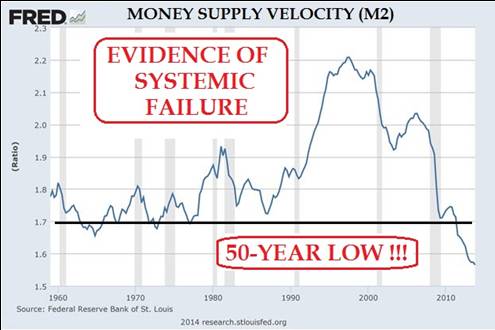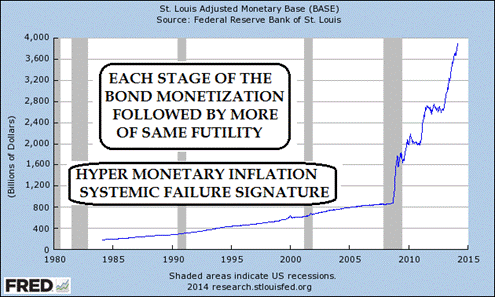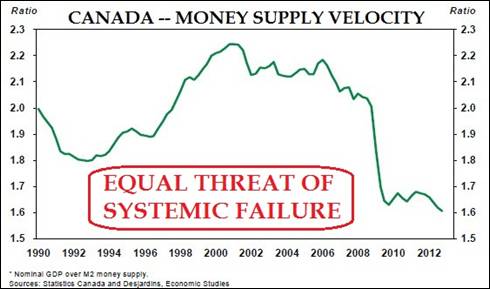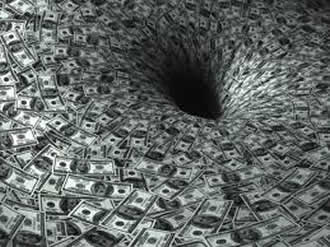The PBOC's willingness to a) enter the global currency war (beggar thy neighbor), and b) 'allow' the Yuan to weaken and thus crush carry traders and leveraged 'hedgers' is about to get serious. The total size of the carry trades and hedges is hard to estimate but Deutsche believes it is around $500bn and as Morgan Stanley notes the ongoing weakness means things can get ugly fast as USDCNY crosses the crucial 6.25 level where losses from hedge products begin to surge. This is a critical level as it pre-dates Fed QE3 and BoJ QQE levels and these are pure levered derivative MtM losses - not a "well they will just rotate to US equities" loss - which means major tightening on credit conditions...
CNY hits a critical level at 6.25...
This is a major problem because...
The seemingly incessant strengthening trend of the Chinese Yuan (much as with the seemingly inexorable rise of US equities or home prices) has encouraged huge amounts of structured products to be created over the past few years enabling traders to position for more of the same in increasingly levered ways. That was all going great until the last few weeks which has seen China enter the currency wars (as we explained here). The problem, among many facing China, is that these structured products will face major losses and as Morgan Stanley warns "real pain will come if CNY stays above these levels," leading to further capital withdrawal, illiquidity, and a potential vicious circle as it appears the PBOC is trying to break the virtuous carry trade that has fueled so much of its bubble economy.
As we noted previously... The total size of the carry trade is hard to estimate although even just looking at some of the onshore CNY positions accumulated, DB Asia FX strategist Perry Kojodjojo estimates that corporate USD/CNY short positions are around $500bn. The size of the carry trade and the fact that China saw significant capital outflows during the last period of substantial Renminbi depreciation in the summer of 2012 has led to concerns over what this might mean for both the Chinese economy and financial markets as well as broader global financial implications.
Morgan Stanley believes that one such carry-trade structured product that will be the "pressure point" for this - should the Yuan continue to depreciate - is the Target Redemption Forward (TRF)which has a payoff that looks as follows...While this is just an example of a product payoff matrix to the holder, the broader point is that the USD/CNH market has a particular level (or range of potential levels) at which three factors can create non-linear price action. These are:1. Losses on TRF products will (on average) crystallize if USD/CNH goes above a certain level. This has implications for holders of TRF products, who are mostly corporates;2. The hedging needs of writers of TRF products (banks) mean that there is a point of maximum vega for banks in USD/CNH. Below this level banks need to sell USD/CNH vol; above this level banks need to buy USD/CNH vol;3. The delta-hedging needs of banks are complex. As we approach the average strike (the 6.15 in the theoretical point of Exhibit 1), banks need to buy spot USD/CNH. Above this point but below the European Knock-in (EKI) (i.e., between 6.15 and 6.20 in Exhibit 1), banks need to sell spot. Then above the EKI, banks don’t need to do anything in spot.From internal Morgan Stanley data, we estimate that the point of maximum vega is somewhere in the range of 6.15-6.20, and that the 6.15-6.20 in Exhibit 1 is reasonably indicative of the average strikes and EKIs in the market.In other words, so long as the TRF products remain in place (i.e., are not closed out) and we remain below the maximum vega point (somewhere between 6.15 and 6.20), there is natural selling pressure by banks in USD/CNH vol. When we get above that level, there is natural vol buying pressure.Of course, in the scenario that USD/CNH keeps trading higher and goes above the average EKI level, the removal of spot selling flow by banks and the need to buy vol means the topside move may accelerate.
Simply put, if the CNY keeps going (whether by PBOC hand or a break of the virtuous cycle above), then things get ugly fast...
How Much Is at Stake?
In their previous note, MS estimated that US$350 billion of TRF have been sold since the beginning of 2013. When we dig deeper, we think it is reasonable to assume that most of what was sold in 2013 has been knocked out (at the lower knock-outs), given the price action seen in 2013.
In their previous note, MS estimated that US$350 billion of TRF have been sold since the beginning of 2013. When we dig deeper, we think it is reasonable to assume that most of what was sold in 2013 has been knocked out (at the lower knock-outs), given the price action seen in 2013.
Given that, and given what business we’ve done in 2014 calendar year to date, we think a reasonable estimate is that US$150 billion of product remains.Taking that as a base case, we can then estimate the size of potential losses to holders of these products if USD/CNH keeps trading higher.In round numbers, we estimate that for every 0.1 move in USD/CNH above the average EKI (which we have assumed here is 6.20), corporates will lose US$200 million a month. The real pain comes if USD/CNH stays above this level, as these losses will accrue every month until the contract expires. Given contracts are 24 months in tenor, this implies around US$4.8 billion in total losses for every 0.1 above the average EKI.
Deutsche Bank concludes...
Looking forward it’s possible that the PBOC is not attempting to actively engineer a sustained depreciation of the Renminbi but rather is attempting to increase the level of two-way volatility in the market to discourage the carry trade and also excessive capital inflows. In terms of the broad risk going forward the sheer scale of the challenge the PBOC has set out to tackle likely means they will have to move with restraint. This is certainly a story to watch...
As Morgan Stanley warns however, this has much broader implications for China...
The potential for US$4.8 billion in losses for every 0.1 above the average EKI could have significant implications for corporate China in its own right, as could the need to post collateral on positions even if the EKI level is not breached.However, the real concern for corporate China is linked to broader credit issues. On that, it’s worth reiterating that the corporate sector in China is the most leveraged in the world. Further loss due to structured products would add further stress to corporates and potentially some of those might get funding from the shadow banking sector. Investment loss would weaken their balance sheets further and increase repayment risk of their debt.In this regard, it would potentially cause investors to become more concerned about trust products if any of these corporates get involved in borrowing through trust products. In this regard, this would raise concerns among investors, given that there is already significant risk of credit defaults to happen in 2014.
Remember, as we noted previously, these potential losses are pure levered derivative losses... not some "well we are losing so let's greatly rotate this bet to US equities" which means it has a real tightening impact on both collateral and liquidity around the world... yet again, as we noted previously, it appears the PBOC is trying to break the world's most profitable and easy carry trade - which has created a massive real estate bubble in their nation (and that will have consequences).
+++++++++++++
The bottom line is the question of whether the PBOC's engineering this CNY weakness is merely a strategy to increase volatility and thus deter carry-trade malevolence (in line with reform policies to tamp down bubbles) OR is it a more aggressive entry into the currency wars as China focuses on its trade (exports) and keeping the dream alive? (Or, one more thing, the former morphs into the latter as a vicious unwind ensues OR the market tests the PBOC's willingness to break their momentum spirit).
The escalation of the unwind in recent days suggests the vicious circle is beginning.
Finally, putting aside speculative trader P&L losses, many of which are said to be of Japanese origin and thus will hardly enjoy much or any PBOC sympathies, here is CLSA's Russel Napier on what the long-tern fate of the Renminbi will be:
“Mercantilist alchemy transmutes China’s external surpluses into foreign exchange reserves and renminbi. But with capital outflows from China at record highs, those surpluses are only maintained due to its citizens’ foreign-currency borrowing. Bank-reserve and M2 growth are already near historical lows and are driving tighter monetary policy. This will lead to severe credit-quality issues and force the authorities to accept a credit crunch or opt for a major devaluation of the renminbi. They will do the latter; and despite five years of QE, the world will get deflation anyway.”
http://www.zerohedge.com/news/2014-04-24/real-pain-about-begin-chinese-currency-slumps-19-month-lows







